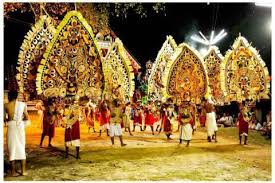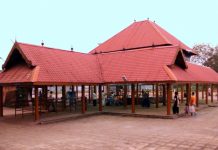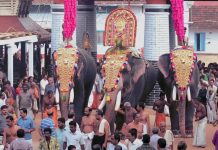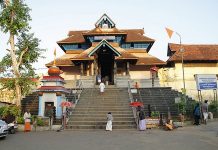Padayani, also known as Padeni (from the Malayalam word for military formations), is a traditional folk dance and a ritual art from the central portion of the Indian state of Kerala. A ceremonial dance involving masks, it is an ancient ritual performed in Bhagavati temples. The dance is performed in honor of Bhadrakaali. Meaning, a ‘row of warriors’, Padayani is an art form that blends all music, dance, theatre, satire, facial masks, and paintings. It is part of the worship of Bhadrakali and is staged in temples dedicated to the goddess from mid-December to mid-May. Padayani is unique to central Travancore, comprising the Pathanamthitta and Kottayam districts of Kerala. Padayani is regarded as a remnant of the Dravidian forms of worship that existed before the advent of Brahmanism.
Padayani is like Theyyam in north Kerala. The percussion instruments used in Patayani are patayani thappu, chenda, para and kumbham.
Etymology
The term Padayani originated from malayalam words ‘Pata’ meaning military and ‘ani’ meaning preparation.
Traditions of origin
Padyani is a modern form of Kolam Thullal, a ritual dance, which had been performed by the magico-medicine men of Kerala ( The Tinta endogamous section of the Ganaka community). In the olden days, this elaborate and expensive event was carried out to heal illnesses of deep psychological dysfunctions without any identifiable serious physical cause, and cases that seemed to be not amenable to medical modalities of intervention. This form of psychic or spiritual healing otherwise known as Kolam Thullal was solely designed, controlled, and performed by the Tinta sub-sect of the Ganaka community, as a method of exorcism. The folk art, Padayani made developed from this dance performance, as a divine ritual tradition in association with festival occasions of Bhagavathy (Bhadrakaali) temples of Kerala.
Another version of its origin is related to the practice of ancient martial arts training in Kerala. Since the origin of the term ‘padayani’ relates to military parade or rows of army, t is generally believed that it evolved from a symbolic past reminiscent of the fencing march of the martial art (Kalari) by the Nair soldiers and their Kalari Asaans. Eventually, the responsibilities of various functions related to this dance were divided and assigned among people of different communities. So the Nair folk became the performers of the modern form of Padayani art, but the right of writing lyrics, design, and making elaborate costumes was vested with the Kaniyar people. Nowadays the modern form of Padayani is performed at many Devi temples in the southern region of Kerala, particularly in Pathanamthitta, Kottayam, Alappuzha, and Kollam Districts.
Design and performance
Padayani is very popular in Kerala, India, as a means, used to worship the Goddess Bhadra Kali. The storyline comes as after killing Daruka, an Asura, the goddess was very angry. The bhoothagana, servants of lord Siva, danced in front of her to reduce her anger, or else her anger would result in the destruction of the whole world. In memory of this incident, the participants wear masks (kolam) made of lathes of the areca tree using one to hundreds. The colours used to make the kolam are purely natural. They are made of the green of the lath itself (kamukin pacha), kari (carbon), manjalpodi, sindooram, etc.
A major attraction of padayani is the song associated with it. Traditionally only a single type of instrument is used to associate the song, thappu. The songs are in simple Malayalam and have been handed down from the ancestors over the years.
The art form starts with heating the musical instrument, thappu (Thappu Choodakkal). The instrument is faced towards the fire and the instrument tuned. After that, the art form starts. Various types of dances have different names such as madan, marutha, yakshi, pakshi, kalan kolam and bhairavi kolam.
Marutha is the little ones and they are like a drama. They are dancing to make fun along with the songs. The kolam is performed by men as well as children.
Kalan Kolam is the major attraction in padayani. This is about a child who is begging for his life with lord Siva, while death comes on his 16th birthday. At that time Kalan, the god of death, comes and he is trying to take the life of Markandaya, the boy.

Bhairavi kolam is the dance to worship the goddess. It is the biggest kolam and uses many laths of the areca tree. The kolam is headed by more than one person due to its heavy weight.
After the kolam thullal is over, there will be ritual called Pooppada which is the end of the padayani festival. After that, the days of colours will be over and the colourful memories will be in the minds.
The waiting for the next padayani starts then…with a prayer for the wellness of all world….
In 2007, plans were put forward to implement a proposal by poet Kadammanitta Ramakrishnan to create a Padayani Village to promote the dance form. As of 2009, the first such village is expected to be built in the poet’s hometown of Kadammanitta at a cost of Rs. 1.9 crore. A chief exponent of Padayani is Prof. Kadammanitta Vasudevan Pillai. His association and acquaintance with Kadammanitta Ramakrishnan have led to many literary contributions. His Literary work “Padayaniyude Paalakolangal” and “Padayani” is an authoritative work on Kerala Folklore with special reference to Padayani.
Myth
A very destructive war between the devas (gods) and the asuras (anti-gods) left only two women, Danavathi and Darumathi, in the asura class. Left to themselves they practiced tapasya (devotion penance) to please Brahma the creator. By his blessings, each begot a son, Danava and Darika. When Darika came of age Darumathi narrated to him the sad tale of the defeat and destruction of their class by the devas. She exhorted him to do penance to please Brahma and obtain powers with which he should retrieve the lost glory of their class. Darika performed arduous tapasya, which Brahma could not ignore, and he blessed him with such powers as may shield him from harm by man or god night and day. Brahma bestowed him with the mighty rod of Brahma, a weapon of great destructive potential. But an arrogant turn by the asura enraged Brahma who added to his devotee’s lucky death by a divine damsel. Darika with the help of the supernal architect Maya built a splendid palace on the shores of the western sea and proclaimed protection and honor to all the surviving members of his class scattered and hiding. With their help, he reconstituted the asura army, fought with Indra the chief of gods, and defeated him. Darika didn’t stop with this. He took intermittent military excursions into the territories of the devas and became a perpetual menace to them. The Gods in distress petitioned Vishnu the great god of preservation who directed them to Shiva who told them that only a goddess of extraordinary prowess could slay Darika. Thus Brahma created Brahmi, Vishnu created Vaishnavi and Shiva Maheswari, Indra Indrani, Subrahmanya Kumari, and Yama Varahi. Their combined effort could not, however, vanquish Darika. Then fate in the form of Narada, the celestial monk, came in Darika’s way.
The haughty asura reproached the saint and threatened to kill him. The distressed Narada went to Kailasa and complained to Shiva about the demonic behaviour. The infuriated Shiva created Bhadrakali out of his third eye and assigned to her the task of destroying the asura. In the battle that followed Bhadrakali killed Darika’s minister. Provoked, Darika decided to confront Kali, but before going to the battlefield he transferred all the powerful mantras (hymns of invocation) to his wife. Darika used the rod of Brahma forcing Kali to retreat. Goddess Kartyayani, an ally of Kali, who knew that Darika was no more the sole owner of the mantras of his success, tricked the asura’s wife disguising herself as an innocent Brahmin girl. With all the powerful mantras of the opponent now with her, Kali fought with Darika and on the twenty-second day she captured the rod of Brahma, cut her opponent’s head, and slaked her thirst with his blood. Kali’s fury raged even after the war ended. Her army of goddesses and phantoms, terrified at the unusual anger of their leader, fled the field and sought refuge in Shiva. Shiva proposed several modes of entertainment to cool her down. Dance, music, comic dialogues, and mime were tried but all in vain. But when Lord Subrahmanya drew her furious form on the ground, and then acted her out with gorgeous accouterment and rhythmic movement, Kali was amused and pleased. This, in brief, is the story behind Padayani.
Mythical narratives of this sort that form the background to art forms like Padayani are also ground for the founding of certain ethics. During succeeding stages of social change meanings were attached ‘figures’ – acted out with the help of accouterment and designs drawn on the floor. The ‘figures’(Kolam in Malayalam) became signifiers with signifieds lying in the religious system that was developing alongside the social system. Padayani, as it is known today, has, apart from its artistic function, the function of relieving the social group of ‘spirits’ that malign body and soul. Each Kolam has a purpose and a meaning, its function is not individual but social.























































